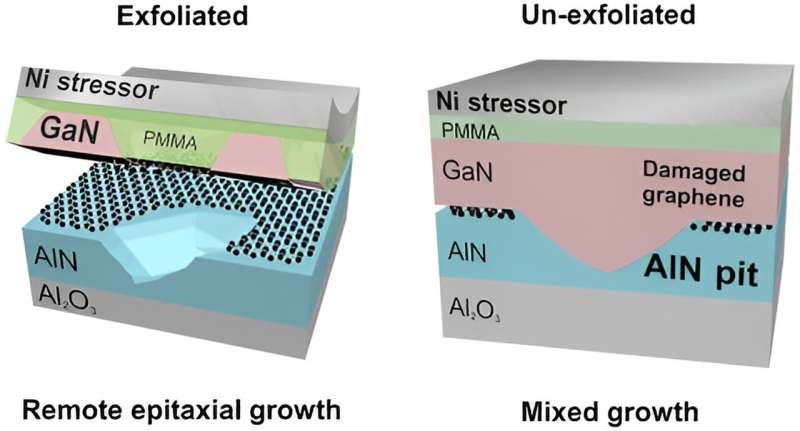
Remote epitaxy has been gaining attention in the field of semiconductor manufacturing for growing thin films that copy the crystal structure of the template, which can later be exfoliated to form freestanding membranes. However, harsh epitaxy conditions can often cause damage to the template materials, such as in the case of remote epitaxy of GaN thin films, promising materials for light-emitting diodes, photodetectors, and power electronic devices, on graphene/AlN templates.
GaN remote heteroepitaxy has not been achieved by a standard metal–organic chemical vapor deposition (MOCVD) technique due to the high temperatures involved in the process. It has been reported that graphene placed on a substrate in an extreme environment such as high temperature or use of an active gas in MOCVD gets damaged due to chemical instability, which causes failure to exfoliate grown GaN films.
Against this background, a team of researchers led by Dong-Seon Lee, Head of the Department of Semiconductor Engineering and Professor at the School of Electrical Engineering and Computer Science at the Gwangju Institute of Science and Technology, has recently used remote epitaxy to grow GaN thin films on graphene/AlN templates by MOCVD and investigated the effect of surface pits in AlN on the growth and exfoliation of these thin films.
Their paper was published in ACS Nano.
The researchers first performed an annealing test at 950 °C for 5 minutes to check the thermal stability of graphene on AlN. Based on its results, they developed a two-step process to grow GaN thin films on the template by MOCVD. The first GaN growth took place at 750 °C for 10 minutes, following which the second growth was performed at 1050 °C for 60 minutes.
The exfoliation of the thus-grown GaN thin films was used as a proof of success of the remote epitaxy process. While the films grown at 750 °C could be exfoliated successfully, the separation failed after the second step growth.
Upon deeper analysis, the team found that the nano-sized pits on AlN surface led to the degradation of graphene near them at higher temperatures, which altered the growth modes of GaN thin films. As a result, GaN directly bonded with the AlN substrate, causing the failure of film exfoliation.
“Through this study, we revealed for the first time that structural problems in the substrate can also cause peeling failure. These results exemplify the importance of chemical and topographic properties of templates for successful remote epitaxy,” says Prof. Lee.
This study provides the primary experimental data that supports the stable implementation of the development of remote epitaxy. When asked about the implications of the present work, Prof. Lee says, “In the near future, GaN remote epitaxy implementation is expected to provide high-quality GaN semiconductors required for the electric vehicle industry. Since substrate recycling is possible, it is expected to change the big picture of the existing semiconductor industry. Further, it will be possible to overcome Moore’s law.”
More information:
Hoe-Min Kwak et al, Stability of Graphene and Influence of AlN Surface Pits on GaN Remote Heteroepitaxy for Exfoliation, ACS Nano (2023). DOI: 10.1021/acsnano.3c02565
Journal information:ACS Nano
Provided by
GIST (Gwangju Institute of Science and Technology)

READ MORE
China Launches First Mission to Land on the Far Side of the Moon
An artist’s rendering of the small rover that will be deployed on the far side [...]
New Software Can Predict Landslides Weeks Before They Happen
A landslide in the Cusco region of Peru destroyed more than 100 houses in March [...]
Scientists thread rows of metal atoms into nanofiber bundles
(a) 3D TMC crystalline structure consisting of TMC nanofibers surrounded by single-atom rows of an [...]
The Psychology Behind Generational Conflict
Older people tend to believe that younger generations lack whatever traits they themselves possess in [...]
In Emotional Video, Will Smith Apologizes To Chris Rock For Slapping Him At Oscars
In a roughly 6-minute video uploaded to Instagram and YouTube on Friday, Will Smith apologized [...]
Frog Foam May Help Deliver Drugs to Human Skin
The researchers retrieved frog foam from the forests of Trinidad and brought it back to [...]
Pirate School: 5 Things You Can Shoot from a Cannon
Cannon© LeStudio/Shutterstock.com For centuries, heavy metal cannons were the epitome of military weaponry. Massive cannons [...]
Engineers tackle hard-to-map class of materials
Rice researchers used four-dimensional scanning transmission electron microscopy to analyze the structure of the material [...]